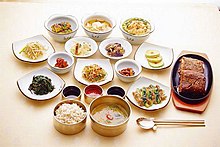Korean dessert Not to be confused with gangjeong.
 Ttangkong-yeot-gangjeong (peanut candy bar) Ttangkong-yeot-gangjeong (peanut candy bar) | |
| Type | Hangwa Candy bar |
|---|---|
| Place of origin | Korea |
| Associated cuisine | Korean cuisine |
| Main ingredients | Toasted seeds, nuts, beans, or puffed grains; mullyeot (rice syrup) |
| Korean name | |
| Hangul | 엿강정 |
|---|---|
| Revised Romanization | yeot-gangjeong |
| McCune–Reischauer | yŏt-kangjŏng |
| IPA | [jʌt̚.k͈aŋ.dʑʌŋ] |
| This article is part of a series on |
| Korean cuisine 한국 요리 조선 료리 |
|---|
 |
| Staples |
|
AncillariesPickled dishes
Soups & stews |
| DessertsHangwa |
DrinksList of Korean drinks
|
| Condiments |
| Utensils |
| Other |
Yeot-gangjeong (엿강정) is a candy bar-like variety of hangwa (traditional Korean confection) consisting of toasted seeds, nuts, beans, or puffed grains mixed with mullyeot (rice syrup). In general households, they usually make and eat yeot-gangjeong during Korean holidays and Jesa. Or, it is made and sold as a winter snack and is usually eaten during holidays and feasts.
Gallery
-
 Cutting yeot-gangjeong
Cutting yeot-gangjeong
-
 Black sesame yeot-gangjeong
Black sesame yeot-gangjeong
-
 Black soybean yeot-gangjeong
Black soybean yeot-gangjeong
-
 Peanut, puffed rice, and raisin yeot-gangjeong
Peanut, puffed rice, and raisin yeot-gangjeong
-
 Puffed rice yeot-gangjeong
Puffed rice yeot-gangjeong
-
 Puffed rice and raisin yeot-gangjeong
Puffed rice and raisin yeot-gangjeong
-
 Sesame yeot-gangjeong
Sesame yeot-gangjeong
-
 Walnut yeot-gangjeong
Walnut yeot-gangjeong
See also
References
- "Yeot-gangjeong" 엿강정. Doopedia (in Korean). Doosan Corporation. Retrieved 7 December 2009.
- Chun, Hui-jung (2004). Yoon, Ho-mi (ed.). Korean Food Guide 800. Seoul: The Korea Foundation. p. 170. ISBN 89-89782-10-4. Retrieved 18 August 2017 – via issuu.
- Kwon, Yong-Seok; Kim, Young; Kim, Yang-Suk; Choe, Jeong-Sook; Lee, Jin-Young (2012). "An Exploratory Study on Kwa-Jung-ryu of Head Families". Journal of the Korean Society of Food Culture (in Korean). 27 (6): 588–597. doi:10.7318/kjfc/2012.27.6.588. Retrieved 18 August 2017.
This Korean dessert-related article is a stub. You can help Misplaced Pages by expanding it. |